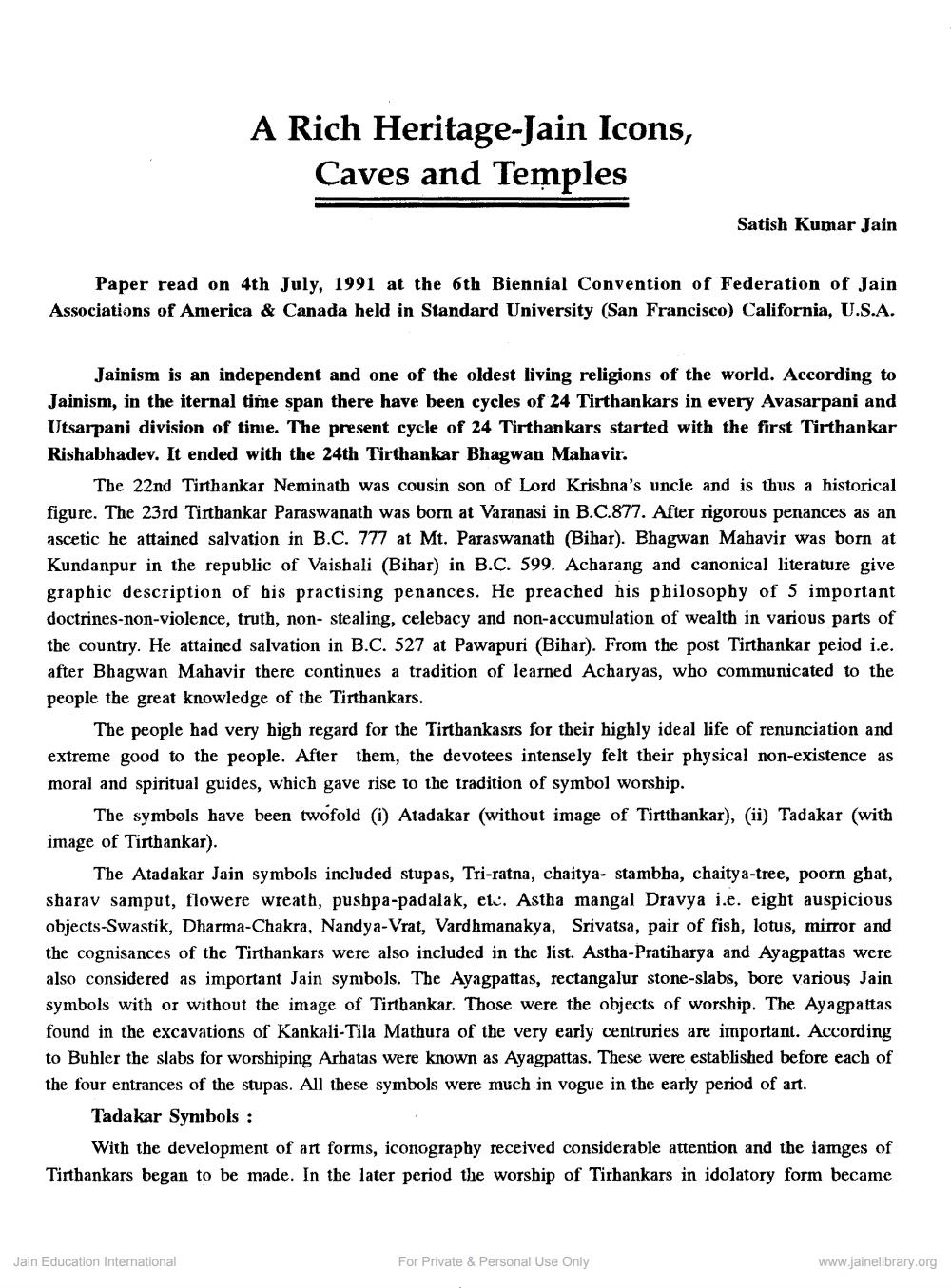________________
A Rich Heritage-Jain Icons,
Caves and Temples
Satish Kumar Jain
Paper read on 4th July, 1991 at the 6th Biennial Convention of Federation of Jain Associations of America & Canada held in Standard University (San Francisco) California, U.S.A.
Jainism is an independent and one of the oldest living religions of the world. According to Jainism, in the iternal time span there have been cycles of 24 Tirthankars in every Avasarpani and Utsarpani division of time. The present cycle of 24 Tirthankars started with the first Tirthankar Rishabhadev. It ended with the 24th Tirthankar Bhagwan Mahavir.
The 22nd Tirthankar Neminath was cousin son of Lord Krishna's uncle and is thus a historical figure. The 23rd Tirthankar Paraswanath was born at Varanasi in B.C.877. After rigorous penances as an ascetic he attained salvation in B.C. 777 at Mt. Paraswanath (Bihar). Bhagwan Mahavir was born at Kundanpur in the republic of Vaishali (Bihar) in B.Ç. 599. Acharang and canonical literature give graphic description of his practising penances. He preached his philosophy of 5 important doctrines-non-violence, truth, non- stealing, celebacy and non-accumulation of wealth in various parts of the country. He attained salvation in B.C. 527 at Pawapuri (Bihar). From the post Tirthankar peiod i.e. after Bhagwan Mahavir there continues a tradition of learned Acharyas, who communicated to the people the great knowledge of the Tirthankars.
The people had very high regard for the Tirtbankasrs for their highly ideal life of renunciation and extreme good to the people. After them, the devotees intensely felt their physical non-existence as moral and spiritual guides, which gave rise to the tradition of symbol worship.
The symbols have been twofold (i) Atadakar (without image of Tirtthankar), (ii) Tadakar (with image of Tirthankar).
The Atadakar Jain symbols included stupas, Tri-ratna, chaitya- stambha, chaitya-tree, poorn ghat, sharav samput, flowere wreath, pushpa-padalak, eto. Astha mangal Dravya i.e. eight auspicious objects-Swastik, Dharma-Chakra, Nandya-Vrat, Vardhmanakya, Srivatsa, pair of fish, lotus, mirror and the cognisances of the Tirthankars were also included in the list. Astha-Pratibarya and Ayagpattas were also considered as important Jain symbols. The Ayagpattas, rectangalur stone-slabs, bore various Jain symbols with or without the image of Tirthankar. Those were the objects of worship. The Ayagpattas found in the excavations of Kankali-Tila Mathura of the very early centruries are important. According to Buhler the slabs for worshiping Arbatas were known as Ayagpattas. These were established before each of the four entrances of the stupas. All these symbols were much in vogue in the early period of art.
Tadakar Symbols :
With the development of art forms, iconography received considerable attention and the iamges of Tirthankars began to be made. In the later period the worship of Tirhankars in idolatory form became
Jain Education International
For Private & Personal Use Only
www.jainelibrary.org




